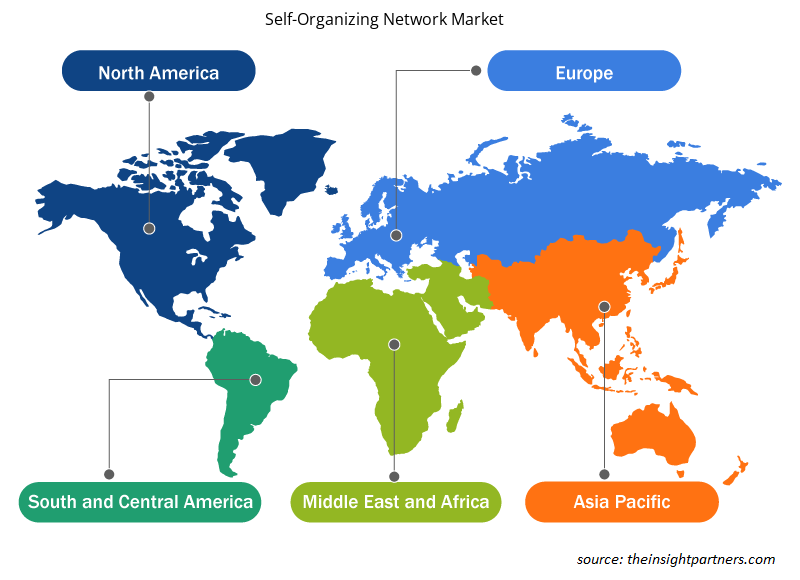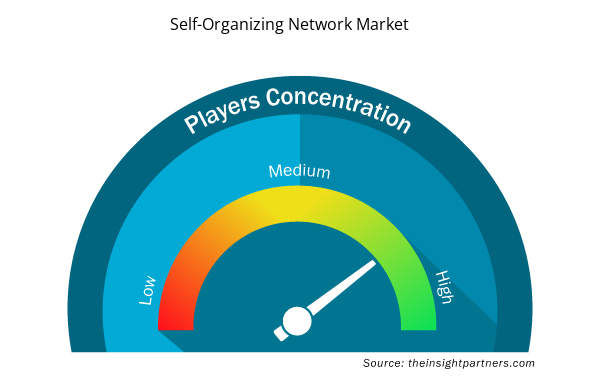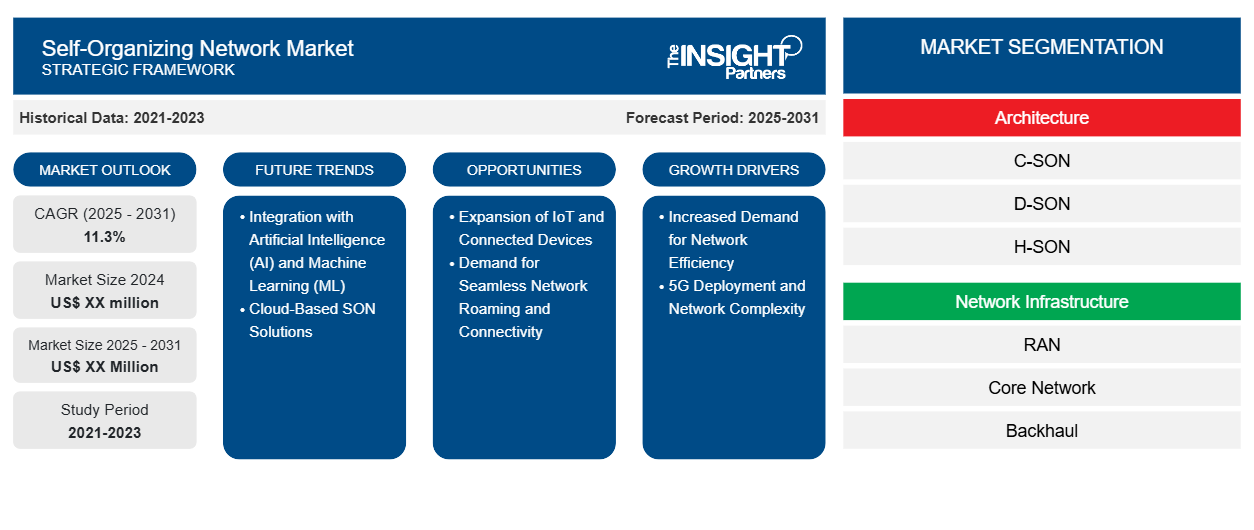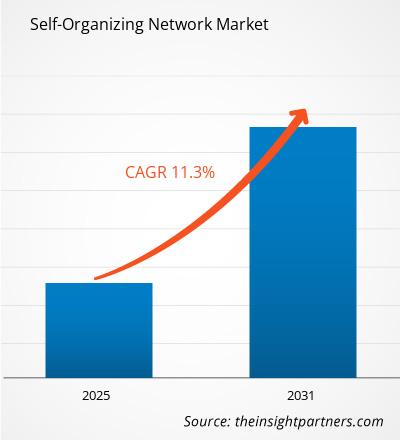The Self-Organizing Network Market is expected to register a CAGR of 11.3% from 2023 to 2031, with a market size expanding from US$ XX million in 2023 to US$ XX Million by 2031.
The report is segmented by Architecture (C-SON, D-SON, and H-SON); Network Infrastructure (RAN, Core Network, Backhaul, and Wi-Fi); and Network Technology (2G/3G, 4G/LTE, and 5G). The global analysis is further broken-down at regional level and major countries. The Report Offers the Value in USD for the above analysis and segments.
Purpose of the Report
The report Self-Organizing Network Market by The Insight Partners aims to describe the present landscape and future growth, top driving factors, challenges, and opportunities. This will provide insights to various business stakeholders, such as:
- Technology Providers/Manufacturers: To understand the evolving market dynamics and know the potential growth opportunities, enabling them to make informed strategic decisions.
- Investors: To conduct a comprehensive trend analysis regarding the market growth rate, market financial projections, and opportunities that exist across the value chain.
- Regulatory bodies: To regulate policies and police activities in the market with the aim of minimizing abuse, preserving investor trust and confidence, and upholding the integrity and stability of the market.
Self-Organizing Network Market Segmentation
Architecture
- C-SON
- D-SON
- H-SON
Network Infrastructure
- RAN
- Core Network
- Backhaul
- Wi-Fi
Network Technology
- 2G/3G
- 4G/LTE
- 5G
Geography
- North America
- Europe
- Asia-Pacific
- South and Central America
- Middle East and Africa
Geography
- North America
- Europe
- Asia-Pacific
- South and Central America
- Middle East and Africa
Customize This Report To Suit Your Requirement
You will get customization on any report - free of charge - including parts of this report, or country-level analysis, Excel Data pack, as well as avail great offers and discounts for start-ups & universities
- Get Top Key Market Trends of this report.This FREE sample will include data analysis, ranging from market trends to estimates and forecasts.
Self-Organizing Network Market Growth Drivers
- Increased Demand for Network Efficiency: The growing need for enhanced network efficiency, especially in mobile and broadband networks, is a major driver for the Self-Organizing Network (SON) market. SONs automate network management, enabling faster deployment, optimization, and troubleshooting. This efficiency reduces human intervention, improves network performance, and minimizes operational costs, making them highly attractive to telecom operators as network traffic continues to increase.
- 5G Deployment and Network Complexity: The rollout of 5G networks is significantly boosting the SON market. 5G networks require highly efficient, scalable, and adaptive management systems due to their increased complexity and demand for high-speed, low-latency connectivity. SON technologies help telecom providers manage the vast number of connected devices and ensure optimal performance across diverse 5G networks.
Self-Organizing Network Market Future Trends
- Integration with Artificial Intelligence (AI) and Machine Learning (ML): The integration of AI and ML into SON technologies is a growing trend. These technologies enable predictive analytics, automated decision-making, and continuous network optimization. By utilizing AI and ML, SONs can better anticipate network issues, improve traffic management, and enhance user experience, allowing telecom operators to proactively manage the network’s health.
- Cloud-Based SON Solutions: Cloud-based SON solutions are becoming increasingly popular due to their scalability, cost-effectiveness, and flexibility. Cloud infrastructure allows for seamless network management and optimization, especially in multi-vendor environments. By moving SON functionalities to the cloud, telecom operators can reduce capital expenditures, enhance network agility, and improve overall service delivery.
Self-Organizing Network Market Opportunities
- Expansion of IoT and Connected Devices: The rapid growth of the Internet of Things (IoT) and the increasing number of connected devices present significant opportunities for SON technologies. As IoT ecosystems grow, the need for efficient network management to handle vast numbers of devices becomes crucial. SON can optimize network performance by dynamically adjusting to traffic patterns, ensuring connectivity and performance.
- Demand for Seamless Network Roaming and Connectivity: As mobile users demand seamless connectivity across regions and networks, SON technologies offer an opportunity to improve network roaming and handovers. By automating network optimization, SONs ensure that users experience uninterrupted services while traveling across different geographic areas or switching between network operators.
Self-Organizing Network Market Regional Insights
The regional trends and factors influencing the Self-Organizing Network Market throughout the forecast period have been thoroughly explained by the analysts at Insight Partners. This section also discusses Self-Organizing Network Market segments and geography across North America, Europe, Asia Pacific, Middle East and Africa, and South and Central America.

- Get the Regional Specific Data for Self-Organizing Network Market
Self-Organizing Network Market Report Scope
| Report Attribute | Details |
|---|---|
| Market size in 2023 | US$ XX million |
| Market Size by 2031 | US$ XX Million |
| Global CAGR (2023 - 2031) | 11.3% |
| Historical Data | 2021-2022 |
| Forecast period | 2024-2031 |
| Segments Covered |
By Architecture
|
| Regions and Countries Covered | North America
|
| Market leaders and key company profiles |
Self-Organizing Network Market Players Density: Understanding Its Impact on Business Dynamics
The Self-Organizing Network Market market is growing rapidly, driven by increasing end-user demand due to factors such as evolving consumer preferences, technological advancements, and greater awareness of the product's benefits. As demand rises, businesses are expanding their offerings, innovating to meet consumer needs, and capitalizing on emerging trends, which further fuels market growth.
Market players density refers to the distribution of firms or companies operating within a particular market or industry. It indicates how many competitors (market players) are present in a given market space relative to its size or total market value.
Major Companies operating in the Self-Organizing Network Market are:
- Airspan Networks Inc.
- Comarch SA
- Telefonaktiebolaget LM Ericsson
- Cisco Systems, Inc.
- Qualcomm Technologies, Inc.
Disclaimer: The companies listed above are not ranked in any particular order.

- Get the Self-Organizing Network Market top key players overview
Key Selling Points
- Comprehensive Coverage: The report comprehensively covers the analysis of products, services, types, and end users of the Self-Organizing Network Market, providing a holistic landscape.
- Expert Analysis: The report is compiled based on the in-depth understanding of industry experts and analysts.
- Up-to-date Information: The report assures business relevance due to its coverage of recent information and data trends.
- Customization Options: This report can be customized to cater to specific client requirements and suit the business strategies aptly.
The research report on the Self-Organizing Network Market can, therefore, help spearhead the trail of decoding and understanding the industry scenario and growth prospects. Although there can be a few valid concerns, the overall benefits of this report tend to outweigh the disadvantages.
- Historical Analysis (2 Years), Base Year, Forecast (7 Years) with CAGR
- PEST and SWOT Analysis
- Market Size Value / Volume - Global, Regional, Country
- Industry and Competitive Landscape
- Excel Dataset

Report Coverage
Revenue forecast, Company Analysis, Industry landscape, Growth factors, and Trends

Segment Covered
This text is related
to segments covered.

Regional Scope
North America, Europe, Asia Pacific, Middle East & Africa, South & Central America

Country Scope
This text is related
to country scope.
Frequently Asked Questions
The Self-Organizing Network Market is estimated to witness a CAGR of 11.3% from 2023 to 2031
The major factors driving the self-organizing network market are:
1. Growing demand for network automation and efficiency.
2.The adoption of 5G networks is growing
Integration with Artificial Intelligence and Machine Learning is likely to remain a key trend in the market.
Key players in the self-organizing network market include Nokia, Cisco Systems, Inc., Telefonaktiebolaget Lm Ericsson, Qualcomm Technologies Inc., Airspan Networks, Innovile, Corning Incorporated , Hughes Systique Corporation, Altran, and Cellwize
Some of the customization options available based on the request are an additional 3-5 company profiles and country-specific analysis of 3-5 countries of your choice. Customizations are to be requested/discussed before making final order confirmation# as our team would review the same and check the feasibility
Trends and growth analysis reports related to Electronics and Semiconductor : READ MORE..
1. Airspan Networks Inc.
2. Comarch SA
3. Telefonaktiebolaget LM Ericsson
4. Cisco Systems, Inc.
5. Qualcomm Technologies, Inc.
6. Cellwize Wireless Technologies Pte Ltd.
7. Nokia
8. P.I. Works
9. Aricent Inc.
10. VIAVI Solutions Inc.




 Get Free Sample For
Get Free Sample For